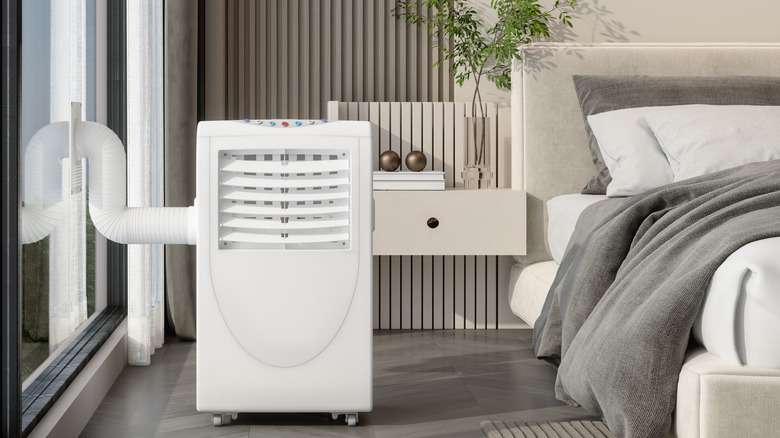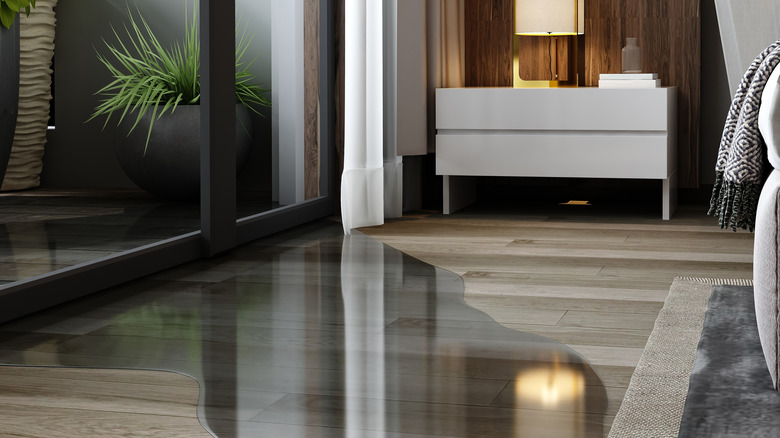How To Drain Your Portable AC (& How Often You Should Do It)
To beat the summer heat, you switch your detective mode on and scour the internet to bring home the best portable air conditioner. Once it gets home, you set it up and plop down in front of the device to enjoy the cool air. Fast forward a few hours, and the AC suddenly turns off. You get up to inspect the device and find the display panel highlighting an error code or need to deal with the indicator lights. Although this might leave you scratching your head and wondering if there's something wrong with your brand-new device, the reason is simple: your portable AC's internal water tank is filled to the brim and must be emptied.
Even though your AC's primary function is to bring down the room's temperature and chill it, it doubles as a dehumidifier. Simply put, the device draws in warm air while cooling the room. While a portion of the collected air is funneled outside your home through the exhaust vent, the leftover air condenses and turns into water. In turn, this water fills the storage tank and needs to be drained for your portable AC to work efficiently. Depending on the humidity in the environment and the device usage, you'll have to drain the tank every few hours, days, or weeks. For instance, if the climate is extremely humid and you use the device round-the-clock, expect to drain the tank every six to eight hours (or sooner), and vice versa.
How to drain your portable AC
Start by turning off the device. Once it's off, remove the plug from the power outlet. If the device feels hot to the touch, give it a few minutes to cool down. Next, remove the vent hose from the unit (if it's detachable). Follow this up by finding the draining port. Usually, you'll find it at the bottom on the back of the AC. Before you remove the drain plug from the port, get a container so the water can drain out without creating a mess on the floor.
A shallow baking tray (or pan), plastic container, or lid is best. But if you don't have any of these items handy, carefully lift the device onto a platform and place a bowl or bucket underneath the draining port. Whatever you position below the drain plug, it should be big enough to handle around 28 ounces of water, or you'll have to empty the container multiple times during drainage (FYI, this could be messy once the water starts flowing). Now, turn the drain cap anti-clockwise to unlock it from the port and gently pull out the drain plug. The water will automatically begin to pour out. After emptying the tank, use a clean microfiber cloth to wipe the wet spots. Finally, put the plug back in place, screw on the cap and the hose before turning on the AC. Alternatively, position the AC over a floor drain or take it outside while draining the tank.
What happens if you don't drain your portable AC
Your portable AC will automatically shut down if you don't drain it once the storage tank is full. This prevents the water from overflowing and spilling onto your floors or other surfaces. Although this sounds horrible, especially if you're battling oppressive heat, this is the best-case scenario. In cases where the device doesn't shut off automatically or the feature doesn't work correctly, water will flow over from the tank. This may damage the functioning AC and flood your floor.
Otherwise, the AC will continue working but not at maximum efficiency. Moreover, it might consume more energy to cool the room. The added pressure will force the device to work overtime to chill the space, reducing its lifespan and causing it to break down. That's not all. Since the water tank will be saturated, it'll fail to perform as a dehumidifier.
Additionally, you'll have to contend with bacterial growth. The unhygienic and moist tank will also attract mold and mildew, negatively impacting your indoor air quality and making it unsafe to use your portable AC. So, when the device shuts down or the indicator lights turn on, heed the warning and drain the device immediately.

